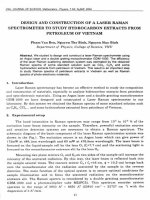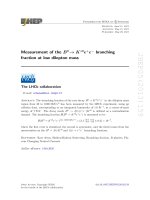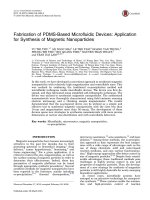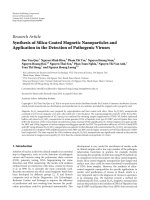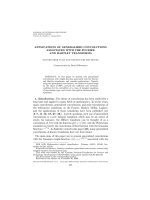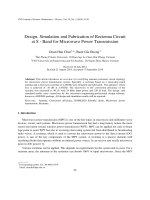DSpace at VNU: Design of iron oxide nanoparticles decorated oleic acid and bovine serum albumin for drug delivery
Bạn đang xem bản rút gọn của tài liệu. Xem và tải ngay bản đầy đủ của tài liệu tại đây (1.34 MB, 24 trang )
Accepted Manuscript
Title: Design of iron oxide nanoparticles decorated oleic acid
and bovine serum albumin for drug delivery
Author: Thao Truong-Dinh Tran Toi Van Vo Phuong Ha-Lien
Tran
PII:
DOI:
Reference:
S0263-8762(15)00011-8
/>CHERD 1765
To appear in:
Received date:
Revised date:
Accepted date:
7-7-2014
23-10-2014
19-12-2014
Please cite this article as: Tran, T.T.-D., Van Vo, T., Tran, P.H.-L.,Design
of iron oxide nanoparticles decorated oleic acid and bovine serum albumin
for drug delivery, Chemical Engineering Research and Design (2015),
/>This is a PDF file of an unedited manuscript that has been accepted for publication.
As a service to our customers we are providing this early version of the manuscript.
The manuscript will undergo copyediting, typesetting, and review of the resulting proof
before it is published in its final form. Please note that during the production process
errors may be discovered which could affect the content, and all legal disclaimers that
apply to the journal pertain.
Design of iron oxide nanoparticles decorated oleic acid and bovine serum
2
albumin for drug delivery
3
Thao Truong-Dinh Tran*, Toi Van Vo and Phuong Ha-Lien Tran*
4
Pharmaceutical Engineering Laboratory, Biomedical Engineering Department, International
5
University, Vietnam National University – Ho Chi Minh City, Vietnam
ip
t
1
cr
6
us
7
an
8
M
9
10
d
11
Ac
ce
p
13
te
12
14
*Correspondence to:
15
Phone: (84-8) - 37244270 Ext. 3337
16
Fax: (84-8) - 37244271
17
E-mail address: (Thao Truong-Dinh Tran)
18
(Phuong Ha-Lien Tran)
1
Page 1 of 23
19
Abstract
This study aimed to originally develop a new nanoparticulate drug delivery system of
21
iron oxide nanoparticles (Fe3O4) for biomedical applications. Oleic acid and bovine serum
22
albumin were decorated on the surface of iron oxide nanoparticles in new pattern by
23
conjugation. The decoration was kicked off by the functionalization of arginine on the surface
24
of the iron oxide nanoparticles. It was then followed by the conjugation of oleic acid and
25
bovine serum albumin through the amide bond. Scanning electron microscopy, transmission
26
electron microscopy, powder X-ray diffraction and Fourier transform infrared spectroscopy
27
were used to characterize and determine mechanism of the decorated nanoparticles.
28
Paclitaxel was chosen as the model drug in the study. The nanoparticles demonstrated a
29
potential utility in delivery of anticancer drugs.
30
Keywords: iron oxide nanoparticles, drug delivery, anticancer drug, oleic acid, bovine serum
31
albumin.
Ac
ce
p
te
d
M
an
us
cr
ip
t
20
2
Page 2 of 23
32
1. Introduction
One of the most important applications of nanotechnology is nanomedicine, which
34
applies the technique to the prevention, diagnosis and treatment of diseases [1-3]. Fabrication
35
of nanoparticles has drawn much interest in developing a new generation of more effective
36
cancer therapies since nanoparticles show highly promising in the improvement of drug
37
efficacy, especially drugs with a narrow therapeutic window or low bioavailability such as
38
anticancer drugs [4]. Moreover, nanoparticles are under particular researches since they can
39
selectively access to tumor due to their small size and versatile modified physicochemical
40
properties [5]. Solid tumors facilitate preferential accumulation of nanosized drug delivery
41
systems due to their specific structure where the vasculature is different in both functional
42
and morphological aspects, from the one in normal tissues [6, 7]. Generally, tumor blood
43
vessels are larger in size, more heterogeneous in distribution and more permeable [8]. The
44
increased vascular permeability and the impaired lymphatic drainage in rapidly growing
45
tumors allow an accumulation of nanoparticles in the tumor [9]. When the absorption occurs,
46
the drug is released. The technique overcomes disadvantages of the conventional solution
47
including rapid clearance from the blood circulation due to low molecular weight, and low
48
accumulation at the tumor site for treatment. In addition, anticancer drugs tend to present
49
with a large volume of distribution leading to toxicity towards healthy tissues due to their
50
small size and/or their high hydrophobicity in the conventional treatment.
Ac
ce
p
te
d
M
an
us
cr
ip
t
33
51
A tool for observation of tumor response during cancer therapy is very important and
52
indispensable in treatment of this disease. Magnetic resonance imaging (MRI) is a common
53
approach widely used for diagnosis in biomedical application. Development of contrast
54
agents for further improving tissue resolution on the image hence, have drawn much interest.
3
Page 3 of 23
Novel nanomedicine based drug delivery systems as directions to deliver anticancer drugs to
56
tumor for effective therapy and diagnostics have been incessantly investigated [10]. Those
57
systems not only reduce side effects of anticancer drugs but also utilize the nano structure as
58
an MRI contrast agent. Iron oxide nanoparticles (IONPs) have emerged as feasible materials
59
for tumor imaging and targeted anticancer drug delivery [11-15]. Various IONPs have been
60
clinically used as contrast agents due to their high contrast effects and biocompatibility.
61
However, the use of these products as a drug carrier system has been still under investigation.
62
It has been reported that under physiological pH conditions the IONPs are not charge and
63
precipitated because the isoelectric point of IONPs is 7 [16]. Consequently, agglomerated
64
particles are rapidly cleared by macrophages in the reticuloendothelial system (RES) before
65
they can reach to target cells [17-20]. One of the feasible approaches is coating the
66
nanoparticles by a biocompatible material [21] which can act to shield the IONPs from
67
surrounding environment and can also be functionalized then. Type of surface coating, its
68
concentration and a wide variety of experimental factors such as stirring rate, stirring time,
69
pH, etc. determine the overall size of the colloids which may also play a significant role in
70
biodistribution [22-24]. Besides, the drug loading capacity of the hydrophobic part depends
71
on compatibility between hydrophobic functional groups and poorly water-soluble drugs
72
encapsulated [25]. A design of surface-modified IONPs hence, would determine drug loading
73
capacity and probably encapsulation efficiency also [25]. Oleic acid (OA) is a biocompatible
74
fatty acid and also an agent that induces the stability of many nanoparticle systems. It can
75
play a role of a capping agent for the particles to form a protective monolayer through a
76
strong bond. Nanoparticles with a hydrophobic coating through the attachment of the polar
77
end groups to the surface hence are obtained with monodisperse and highly uniform [26, 27].
Ac
ce
p
te
d
M
an
us
cr
ip
t
55
4
Page 4 of 23
The system with oleic acid coating only is not suitable for biomedical applications because
79
they possess hydrophobic surfaces with a large surface area to volume ratio which cause
80
agglomeration and formation of large clusters, resulting in the increased particle size [28].
81
However, OA is the essential part of the IONPs coating for anticancer hydrophobic drug to be
82
loaded [29]. Therefore, for biomedical applications in aqueous environments, in addition to
83
OA part, the presence of a hydrophilic coating is favorable. Albumin nanoparticles have
84
recently withdrawn attraction due to the preparation under mild conditions and the capability
85
of various kinds of molecules incorporation [30]. Bovine serum albumin (BSA) is a
86
preferable carrier in drug delivery systems to facilitate sophisticated biological nanostructures
87
easily adaptable to human body [31]. The surface of the IONPs hence, was further conjugated
88
with BSA. Paclitaxel, a hydrophobic anticancer agent, was chosen in the study as the model
89
drug. The decorated multifunctional nanoparticles in this research is expected to offer
90
advantages over conventional formulations in further studies including combination of
91
effective tumor treatment and tumor observation during the therapy, and reducing the side
92
effects of chemotherapy.
cr
us
an
M
d
te
Ac
ce
p
93
ip
t
78
94
2. Materials and Methods
95
2.1 Materials
96
L-arginine,
iron
oxide
(NHS),
nanoparticles
(Fe3O4
-
LOT#MKBG0737V),
dicyclohexylcarbodiimide
(DCC),
N-
97
hydroxysuccinimide
2-(N-
98
morpholino)ethanesulfonic acid (MES) were purchased from Sigma-Aldrich (St Louis, MO,
99
USA). N,N-Dimethylformamide, oleic acid, triethylamine, sodium hydroxide, potassium
5
Page 5 of 23
dihydrogen phosphate were purchased from Xilong Group (China). Bovine serum albumin
101
(BSA – LOT#0000079719) powder was purchased from Himedia Laboratories Pvt. Ltd.
102
(India). Sodium phosphate was purchase from Guangdong Guanhua Sci-Tech Co., Ltd.
103
(China). 1-ethyl-3-(3-dimethylamino-propyl) carbodiimide hydrochloride (EDC) was
104
purchased from Merck Schuchardt (Germany). The solvents used were high-performance
105
liquid chromatography (HPLC) grade. All other chemicals were of analytical grade and were
106
used without further purification.
us
cr
ip
t
100
an
107
2.2 Methods
109
2.2.1. Preparation of IONPs decorated by OA and BSA
110
2.2.1.1 Amine functionalization of IONPs
M
108
500 mg IONPs was firstly dispersed in 50 ml pH 6 (KH2PO4 0.1M, adjusted by NaOH
112
1M) by the tip sonicator in 5 min with 25 W of power supply (Qsonica, Model No. Q700) at
113
room temperature. L-arginine was dissolved in pH 6 buffer (prepared as mentioned above) to
114
yield a solution of 1.25 mg/ml. Then, 50 ml L-arginine solution was added to dispersed-
115
IONPs. This mixture was continuously sonicated in 30 min with 10 W of power supply at
116
room temperature. The amine-functionalized IONPs (A-IONPs) were separated by an
117
external magnet (5 cm in length) and the solution was discarded. 100 ml of distilled water
118
was then added to the nanoparticles for washing. The washing process was repeated thrice.
119
The sample was then dried in oven at 40 ˚C.
Ac
ce
p
te
d
111
120
121
2.2.1.2 Conjugation of OA to A-IONPs
6
Page 6 of 23
OA was conjugated to the free amine on IONPs through an amide bond linkages
123
between carboxylates and amines [32]. Firstly, 100 mg OA was activated by DCC and NHS
124
(1:1:1) in 20 ml dimethylformamide containing 1% triethylamine (DMF-TEA) for 30 min. A
125
dispersion of 500 mg A-IONPs in 50 ml DMF-TEA was then added to the above mixture so
126
that the activated OA could react with the free amine on IONPs. This mixture was
127
magnetically stirred in 120 min for the reaction (stirring rate 700 rpm with 5cm in length of
128
magnetic bar). The final product (OA-IONPs) was separated by an external magnet and
129
washed with dimethylformamide (similar to washing process in 2.2.1.1). The sample was
130
then dried in oven at 40 ˚C.
an
us
cr
ip
t
122
132
M
131
2.2.1.3 Conjugation of BSA to OA-IONPs
BSA was also conjugated to the residual free amine on OA-IONPs through an amide
134
bond linkages between carboxylates and amines [32]. First, 150 mg of BSA was activated by
135
408 mg of EDC and 302 mg of NHS in 250 ml MES buffer (pH 6). This mixture was kept
136
magnetically stirring for 30 min at room temperature (stirring rate 700 rpm with 5cm in
137
length of magnetic bar). The activated BSA was then reacted with the residual amine group
138
by adding 250 ml of pH 7.5 (16% of NaH2PO4 0.1M and 84% of Na2HPO4 0.1M, adjusted by
139
NaOH 1M) containing 300 mg of OA-IONPs to the above mixture. The BSA-conjugated
140
OA-IONPs (BOA-IONPs) were obtained after 120 min and introduced to the separation by
141
an external magnet and then, washed with distilled water (similar to washing process in
142
2.2.1.1). The sample was finally dried in oven at 40 ˚C.
Ac
ce
p
te
d
133
143
144
2.2.2. Paclitaxel loading in BOA-IONPs
7
Page 7 of 23
Firstly, BOA-IONPs were dispersed in distilled water at the concentration of 2.5
146
mg/ml. Then, solution of 100 µl of paclitaxel in ethanol (50 mg/ml) was added to 20 ml of
147
BOA-IONPs suspension. The nanoparticle suspension was left for 5h under stirring.
148
Paclitaxel-loaded BOA-IONPs were separated by a magnet and washed several times with
149
distilled water. The total amount of paclitaxel in the supernatant and washing solution was
150
measured to determine the percentage of drug loading and loading efficiency. All
151
measurements were performed in triplicate. The Paclitaxel loading efficiency and % drug
152
loading of the process were calculated as follows:
an
M
153
157
158
159
,
te
− =- Where:
Ac
ce
p
156
%
d
154
155
us
cr
ip
t
145
x: initial amount of paclitaxel for loading
y: amount of free paclitaxel in supernatant and washing solution
z: total amount of blank nanoparticles and loaded paclitaxel
2.2.3. Paclitaxel release studies
160
Paclitaxel-loaded BOA-IONPs (5 mg) were placed in a test tube containing 10 ml of
161
phosphate buffer (pH 7.4) and then, incubated in a shaking water bath at 37 °C (The shaking
162
frequency is 120 rpm). At pre-determined time intervals, paclitaxel-loaded BOA-IONPs were
8
Page 8 of 23
separated using an external magnet. While these nanoparticles were re-suspended in 10 ml of
164
pH 7.4 fresh buffer for the continuous release study, the amount of paclitaxel released was
165
determined from the aliquot using HPLC. All experiments were performed in triplicate.
166
Percent cumulative release rate of paclitaxel were calculated as follows:
cr
167
ip
t
163
xn: % drug release at n hour
169
xbefore n: % drug release at the time point just before n hour
170
171
172
Ac
ce
p
te
d
M
an
us
168
2.2.4. HPLC analysis
Paclitaxel concentration was determined by HPLC system (Dionex UltiMate 3000,
173
Thermoscientific Inc., USA) with Luna 5µ C18 analytical column (150x4.6 mm).
174
Acetonitrile and distilled water at the ratio 67:33 was used as mobile phase with the flow rate
175
at 1 ml/min. The UV detector was set to a wavelength of 227 nm. The running time was 5
176
min. The standard solutions were constructed in the range of 0.5–20 ppm for
9
Page 9 of 23
177
calibration with good linearity (R2= 0.9997). Acetonitrile was used as diluted solution and
178
blank solution. Twenty microliters of samples were injected into HPLC system for analysis.
179
2.2.5. Scanning electron microscopy (SEM) and Transmission electron microscopy (TEM)
ip
t
180
SEM (JSM-6480LV, Jeol, USA) was used to characterize surface morphology of
182
nanoparticles. Fried sample was deposited on a carbon tape and coated with a thin layer of
183
Platin. All samples were examined under accelerating voltage of 10 kV.
us
cr
181
Also, TEM (JEM-1400 plus, Jeol, USA) was used to examine nanoparticle
185
morphology. A drop of nanoparticles dispersion was placed on a copper grid. Acceleration
186
voltage was kept constant at 100kV.
2.2.6. Powder X-ray diffraction (PXRD)
d
188
M
187
an
184
A D8 Advance diffractometer (Bruker, Germany) using Ni-filtered, CuKα (λ =
190
1.54060 Å) radiation, was used to investigate the crystallinity of the samples. Samples were
191
held on quartz frame. Diffraction pattern was obtained at a voltage of 40kV and at a current
192
of 40 mA. The samples were scanned in increments of 0.02o from 5o to 80o (diffraction angle
193
2θ) at 1 sec/step, using a zero background sample holder.
195
Ac
ce
p
194
te
189
2.2.7. Fourier transform infrared spectroscopy (FTIR)
196
A FTIR spectrophotometer (Bruker Vertex 70, Germany) was used to investigate the
197
spectra of functionalized iron oxide nanoparticles. The wavelength was scanned from 500 to
198
4000 cm-1 with a resolution of 2 cm-1. KBr pellets were prepared by gently mixing 1 mg of
199
the sample with 200 mg KBr.
10
Page 10 of 23
200
3. Results and discussion
201
3.1. Characterization of BOA-IONPs
In this study, surface of IONPs was decorated with OA and BSA for biomedical
203
applications of theranostics (Figure 1). Arginine was firstly coated on the surface of IONPs.
204
The presence of the free amine group provided an opportunity for the conjugation of OA and
205
BSA through the formation of amide bond. BSA offered the biocompatibility enhancement of
206
nanoparticles; whereas, OA molecule was used to carry the poorly water-soluble drug.
us
cr
ip
t
202
207
an
208
209
NH2
211
NH
2
212
te
C
NH
NH
O
Ac
ce
p
O
C
O
NH
NH
C
R1
O
NH
N
H
222
R1
C
221
O
O
C
C
C
O
R2
NH
220
C
H
N
219
R2
O
218
2
NH
R1
R2
217
NH2
NH2
216
HN
NH
2
215
2
NH
d
2
213
214
M
210
R2
R2
223
Figure 1. Illustration of synthesis iron oxide nanoparticles decorated oleic acid and bovine
224
serum albumin (R1 - conjugated oleic acid, R2 – conjugated bovine serum albumin).
12
Page 11 of 23
The morphology of BOA-IONPs was observed by SEM (Figure 2A) and TEM
226
(Figure 2C, 2D). Generally, these nanoparticles had an average diameter of 28.33 ± 5.77 nm.
227
They are a fairly uniform size distribution, spherical shape with a smooth surface as showed
228
in the SEM image. Figure 2C and 2D show that BOA-IONPs were covered by the outer layer
229
as compared to IONPs (Figure 2B) and had the diameter below 50 nm. These results
230
indicated that OA and BSA were potentially functionalized on the surface of IONPs.
cr
ip
t
225
(B)
te
231
d
M
an
us
(A)
(C)
Ac
ce
p
(D)
232
233
234
Figure 2. SEM of BOA-IONPs (A) and TEM images of IONPs (B), BOA-IONPs (C, D)
13
Page 12 of 23
To investigate whether the crystalline structure of IONPs in BOA-IONPs was
236
changed or not, PXRD was used to analyze the samples of IONPs and BOA-IONPs. The
237
PXRD diffractogram of IONPs indicated a highly crystalline structure with characteristic
238
peaks at 30.2º, 35.7º, 43.3º, 57.2º and 62.9º (Figure 3). The functionalization of amine groups
239
and conjugation of OA and BSA on the surface on IONPs did not affect those peaks. In other
240
words, the characteristic peaks of IONPs still maintained under the conditions. Therefore, the
241
PXRD results confirmed the the nanocrystalline structure of Fe3O4 [33] in BOA-IONPs.
us
cr
ip
t
235
Ac
ce
p
te
d
M
an
242
14
Page 13 of 23
The formation mechanism of nanoparticles was elucidated through FTIR analysis.
248
Figure 4 shows FTIR spectra of OA, A-IONPs and OA-IONPs. Regarding the FTIR
249
spectrum of A-IONPs, the peak at 580 cm-1 can be attributed to the vibration of Fe-O [34].
250
The peaks of arginine at 1610 and 1419 cm−1 are those of COO− asymmetric and symmetric
251
stretch, respectively [35] which were shifted to 1648 and 1400 cm−1 in the coated particles.
252
These results suggested the binding of the carboxylic group of arginine to the IONPs. The
253
presence of amine groups from arginine provides a means to conjugate OA and BSA.
254
Regarding the FTIR spectrum of OA, the carbonyl group of OA was showed at 1710 cm-1. It
255
has been reported that the strong C=O absorption will be shifted to lower wavenumbers if the
256
molecule is conjugated [36, 37]. In this case, the C=O peak was shifted to right at 1640 cm-1
257
which was attributed to the peak of amide bond formation [38-40]. This result confirmed that
258
OA was successfully conjugated to the amine groups. Moreover, BSA was also conjugated to
259
the surface of nanoparticles to provide hydrophilicity and increase the motility in biological
260
fluids. As showed in Figure 5, the peak of amide bond in OA-IONPs was at 1640 cm-1 as
261
explained above. However, this peak was stronger in the spectrum of BOA-IONPS which
262
was attributed to the formation of another amide bond because of the conjugation of BSA and
263
amine group [39]. Besides, the peak at 580 cm-1 which can be attributed to the vibration of
264
Fe-O also appeared in BOA-IONPs. Therefore, these results confirmed the conjugation of
265
BSA and OA-IONPs.
Ac
ce
p
te
d
M
an
us
cr
ip
t
247
266
267
268
269
15
Page 14 of 23
1400
an
us
1648
cr
1710
A - IONPs
ip
t
OA
OA - IONPs
2000
1500
1000
500
-1
Wavelength (cm )
d
270
2500
M
3000
1640
Figure 4. FT-IR spectra of oleic acid (OA), arginine-functionalization iron oxide
272
nannoparticles (A-IONPs) and iron oxide nanoparticles decorated oleic acid (OA-IONPs).
Ac
ce
p
273
te
271
16
Page 15 of 23
cr
ip
t
273
us
1540
BOA - IONPs
1560
1580
an
1640
1540
1580
d
1560
M
BSA
te
OA - IONPs
Ac
ce
p
1640
2000
274
1800
1600
1400
1200
1000
800
600
Wavelength (cm-1)
275
Figure 5. FT-IR spectra of OA-IONPs, bovine serum albumin (BSA) and iron oxide
276
nanoparticles decorated oleic acid and bovine serum albumin (BOA-IONPs).
277
17
Page 16 of 23
278
3.3. Paclitaxel loading and encapsulation efficiency
In this study, paclitaxel was chosen as anticancer drug. Paclitaxel was loaded in BOA-
280
IONPs by adsorption on oleic moiety under stirring. Percentage of drug loading and
281
encapsulation efficiency were measured by indirect method. The amount of paclitaxel loading
282
was calculated from unencapsulated drug in the supernatant by HPLC analysis. Paclitaxel
283
was successfully loaded in BOA-IONPs with high encapsulation efficiency. Specifically,
284
percentage of encapsulation efficiency was measured to be 93% ± 2.8%. Percentage of
285
paclitaxel loading was 8.5% ± 0.23%.
an
us
cr
ip
t
279
287
M
286
3.4. In vitro release study
Figure 6 shows that the percent cumulative release rate of paclitaxel from BOA-IONPs
289
at pH 7.4 in 30 days. The release profile demonstrates a burst release observed at the initial
290
stage, followed by a slower and continuous release. Particularly, paclitaxel was released 14%,
291
24% and 34 % after 1, 2, 4 days, respectively. A gradual decrease in release rate was
292
observed after 4 days. The initial burst release offers an opportunity to obtain high
293
concentrations of paclitaxel in the target tissue while the potential of prolonged release offers
294
the ability to prevent persistent excessive vascular smooth muscle cell proliferation [41]. The
295
rapid release at the initial time may be due to the adsorption of drug on the exterior surface
296
[42] and hydrophilic regions. The prolonged release may be attributed to the drug attached to
297
OA [43].
Ac
ce
p
te
d
288
298
18
Page 17 of 23
299
Ac
ce
p
te
d
M
an
us
cr
ip
t
300
19
Page 18 of 23
demonstrated the successful conjugation of OA and BSA on the surface of iron oxide
308
nanoparticles. More importantly, it was found that paclitaxel was loaded in BOA-IONPs with
309
a high encapsulated efficiency. The in vitro release paclitaxel suggested that BOA-IONPs
310
could be a promising dug carrier for cancer therapy. Moreover, the current nanoparticles with
311
magnetic core are potential for theranostics. Further studies are required to evaluate the
312
application of these nanoparticles in diagnostic.
cr
ip
t
307
an
314
us
313
Acknowledgments:
This research is funded by Vietnam National University – Ho Chi Minh City under
316
grant number C2014-28-09. We would like to thank to International University for their
317
continued, generous and invaluable support to our studies as well as greatly boost the
318
efficiency of our research activities. We also thank to Mr. Khanh Nghia Tran for his research
319
assistance in the preparation of nanoparticles.
d
te
Ac
ce
p
320
M
315
20
Page 19 of 23
References
321
322
323
324
325
326
327
328
329
330
331
332
333
334
335
336
337
338
339
340
341
342
343
344
345
346
347
348
349
350
351
352
353
354
355
356
357
358
359
360
361
362
363
364
365
366
367
368
[1] P.H.-L. Tran, T.T.-D. Tran, T.V. Vo, Polymer Conjugate-Based Nanomaterials for Drug Delivery, J.
Nanosci. Nanotechnol., 14 (2014) 815-827.
[2] S. Bamrungsap, Z. Zhao, T. Chen, L. Wang, C. Li, T. Fu, W. Tan, Nanotechnology in therapeutics: a
focus on nanoparticles as a drug delivery system, Nanomed., 7 (2012) 1253-1271.
[3] X.-X. Song, Z.-J. Liu, Q. Tang, Folate Grafted Prussian Blue Entrapped with Gadolinium(III) as a
New Contrast Agent for Tumor-Targeted Magnetic Resonant Imaging, J. Nanosci. Nanotechnol., 13
(2013) 5233-5239.
[4] N.P. Praetorius, T.K. Mandal, Engineered Nanoparticles in Cancer Therapy, Recent Pat. Drug
Delivery Formulation, 1 (2007) 37-51.
[5] P. Gill, Nanocarriers, nanovaccines, and nanobacteria as nanobiotechnological concerns in
modern vaccines, Sharif University of Technology, 20 (2013) 1003-1013.
[6] J.K. Vasir, M.K. Reddy, V.D. Labhasetwar, Nanosystems in Drug Targeting: Opportunities and
Challenges, Current Nanoscience, 1 (2005) 47-64.
[7] C. Jiang, J. Niu, M. Li, Y. Teng, H. Wang, Y. Zhang, Tumor Vasculature-Targeted Recombinant
Mutated Human TNF-α Enhanced the Antitumor Activity of Doxorubicin by Increasing Tumor Vessel
Permeability in Mouse Xenograft Models, PLoS One, 9 (2014) e87036.
[8] S.H. Jang, M.G. Wientjes, D. Lu, J.L.-S. Au, Drug delivery and transport to solid tumors, Pharm.
Res., 20 (2003) 1337-1350.
[9] A. Tiwari, A. Tiwari, Bioengineered Nanomaterials, Taylor & Francis, 2013.
[10] P.H. Tran, T.T. Tran, T.V. Vo, B.J. Lee, Promising iron oxide-based magnetic nanoparticles in
biomedical engineering, Arch. Pharm. Res., 35 (2012) 2045-2061.
[11] A. Kumar, P.K. Jena, S. Behera, R.F. Lockey, S. Mohapatra, S. Mohapatra, Multifunctional
magnetic nanoparticles for targeted delivery, Nanomedicine : nanotechnology, biology, and
medicine, 6 (2010) 64-69.
[12] E. Munnier, S. Cohen-Jonathan, C. Linassier, L. Douziech-Eyrolles, H. Marchais, M. Soucé, K.
Hervé, P. Dubois, I. Chourpa, Novel method of doxorubicin–SPION reversible association for
magnetic drug targeting, Int. J. Pharm., 363 (2008) 170-176.
[13] S. Liu, B. Jia, R. Qiao, Z. Yang, Z. Yu, Z. Liu, K. Liu, J. Shi, H. Ouyang, F. Wang, M. Gao, A Novel
Type of Dual-Modality Molecular Probe for MR and Nuclear Imaging of Tumor: Preparation,
Characterization and in Vivo Application, Mol. Pharm., 6 (2009) 1074-1082.
[14] U.O. Häfeli, J.S. Riffle, L. Harris-Shekhawat, A. Carmichael-Baranauskas, F. Mark, J.P. Dailey, D.
Bardenstein, Cell Uptake and in Vitro Toxicity of Magnetic Nanoparticles Suitable for Drug Delivery,
Mol. Pharm., 6 (2009) 1417-1428.
[15] M. Talelli, C.J.F. Rijcken, T. Lammers, P.R. Seevinck, G. Storm, C.F. van Nostrum, W.E. Hennink,
Superparamagnetic Iron Oxide Nanoparticles Encapsulated in Biodegradable Thermosensitive
Polymeric Micelles: Toward a Targeted Nanomedicine Suitable for Image-Guided Drug Delivery,
Langmuir, 25 (2009) 2060-2067.
[16] Q.A. Acton, Epoxy Compounds—Advances in Research and Application: 2013 Edition,
ScholarlyEditions, 2013.
[17] S.M. Moghimi, A.C. Hunter, J.C. Murray, Long-Circulating and Target-Specific Nanoparticles:
Theory to Practice, Pharmacol. Rev., 53 (2001) 283-318.
[18] B. Romberg, W.E. Hennink, G. Storm, Sheddable coatings for long-circulating nanoparticles,
Pharm. Res., 25 (2008) 55-71.
[19] V.P. Torchilin, V.S. Trubetskoy, Which polymers can make nanoparticulate drug carriers longcirculating?, Adv. Drug Delivery. Rev., 16 (1995) 141-155.
[20] M. Vittaz, D. Bazile, G. Spenlehauer, T. Verrecchia, M. Veillard, F. Puisieux, D. Labarre, Effect of
PEO surface density on long-circulating PLA-PEO nanoparticles which are very low complement
activators, Biomaterials, 17 (1996) 1575-1581.
Ac
ce
p
te
d
M
an
us
cr
ip
t
320
21
Page 20 of 23
te
d
M
an
us
cr
ip
t
[21] T. Neuberger, B. Schöpf, H. Hofmann, M. Hofmann, B. von Rechenberg, Superparamagnetic
nanoparticles for biomedical applications: Possibilities and limitations of a new drug delivery system,
J. Magn. Magn. Mater., 293 (2005) 483-496.
[22] F. Roohi, J. Lohrke, A. Ide, G. Schütz, K. Dassler, Studying the effect of particle size and coating
type on the blood kinetics of superparamagnetic iron oxide nanoparticles, Int. J. Nanomedicine, 7
(2012) 4447.
[23] E.D. Smolensky, H.Y.E. Park, T.S. Berquó, V.C. Pierre, Surface functionalization of magnetic iron
oxide nanoparticles for MRI applications–effect of anchoring group and ligand exchange protocol,
Contrast Media Mol. Imaging, 6 (2011) 189-199.
[24] H. Mohammad-Beigi, S. Yaghmaei, R. Roostaazad, H. Bardania, A. Arpanaei, Effect of pH, citrate
treatment and silane-coupling agent concentration on the magnetic, structural and surface
properties of functionalized silica-coated iron oxide nanocomposite particles, Physica E: Lowdimensional Systems and Nanostructures, 44 (2011) 618-627.
[25] D. Smejkalova, K. Nešporová, G. Huerta-Angeles, J. Syrovatka, D. Jirak, A. Gálisová, V. Velebny,
Selective in vitro anticancer effect of superparamagnetic iron oxide nanoparticles loaded in
hyaluronan polymeric micelles, Biomacromolecules, (2014).
[26] L.M. Bronstein, X. Huang, J. Retrum, A. Schmucker, M. Pink, B.D. Stein, B. Dragnea, Influence of
Iron Oleate Complex Structure on Iron Oxide Nanoparticle Formation, Chem. Mater., 19 (2007) 36243632.
[27] L. Zhang, R. He, H.-C. Gu, Oleic acid coating on the monodisperse magnetite nanoparticles, Appl.
Surf. Sci., 253 (2006) 2611-2617.
[28] J. Huang, L. Wang, R. Lin, A.Y. Wang, L. Yang, M. Kuang, W. Qian, H. Mao, Casein-Coated Iron
Oxide Nanoparticles for High MRI Contrast Enhancement and Efficient Cell Targeting, ACS Appl.
Mater. Interfaces, 5 (2013) 4632-4639.
[29] T.K. Jain, M.A. Morales, S.K. Sahoo, D.L. Leslie-Pelecky, V. Labhasetwar, Iron Oxide Nanoparticles
for Sustained Delivery of Anticancer Agents, Mol. Pharm., 2 (2005) 194-205.
[30] M. Karimi, P. Avci, R. Mobasseri, M.R. Hamblin, H. Naderi-Manesh, The novel albumin-chitosan
core-shell nanoparticles for gene delivery: preparation, optimization and cell uptake investigation, J
Nanopart Res, 15 (2013) 1651.
[31] R. M., M. Jahanshahi, G.D. Najafpour, Production of biological nanoparticles from bovine serum
albumin for drug delivery, Afr. J. Biotechnol., 5 (2006) 1918-1923.
[32] G.T. Hermanson, Chapter 3 - Zero-Length Crosslinkers, in: G.T. Hermanson (Ed.) Bioconjugate
Techniques (Second Edition), Academic Press, New York, 2008, pp. 213-233.
[33] H. Yang, C. Zhang, X. Shi, H. Hu, X. Du, Y. Fang, Y. Ma, H. Wu, S. Yang, Water-soluble
superparamagnetic manganese ferrite nanoparticles for magnetic resonance imaging, Biomaterials,
31 (2010) 3667-3673.
[34] I.J. Bruce, T. Sen, Surface Modification of Magnetic Nanoparticles with Alkoxysilanes and Their
Application in Magnetic Bioseparations, Langmuir, 21 (2005) 7029-7035.
[35] N. Ahmad, M. Ahmad, M. Aslam, S.N. Singh, S.S. Talwar, Synthesis of Arginine Functionalized
Iron Oxide Nanorods, Advanced Science, Engineering and Medicine, 4 (2012) 132-136.
[36] A. Kolbe, C. Griehl, S. Biehler, Molecular interactions in conjugates of dicarboxylic acids and
amino acids, J. Mol. Struct., 661-662 (2003) 239-246.
[37] N. Nakamura, F. Kiuchi, Y. Tsuda, Infrared Spectra of Conjugated Amides : Reassignment of the
C=O and C=C Absorptions, Chem. Pharm. Bull., 36 (1988) 2647-2651.
[38] D.H. Lee, R.A. Condrate, FTIR spectral characterization of thin film coatings of oleic acid on
glasses: I. Coatings on glasses from ethyl alcohol, J. Mater. Sci., 34 (1999) 139-146-146.
[39] B. Ou, D. Li, Preparation of polystyrene/silica nanocomposites by radical copolymerization of
styrene with silica macromonomer, Science in China Series B: Chemistry, 50 (2007) 385-391.
[40] X. Yuan, H. Li, Y. Yuan, Preparation of cholesterol-modified chitosan self-aggregated
nanoparticles for delivery of drugs to ocular surface, Carbohydr. Polym., 65 (2006) 337-345.
Ac
ce
p
369
370
371
372
373
374
375
376
377
378
379
380
381
382
383
384
385
386
387
388
389
390
391
392
393
394
395
396
397
398
399
400
401
402
403
404
405
406
407
408
409
410
411
412
413
414
415
416
417
418
22
Page 21 of 23
[41] U. Westedt, M. Kalinowski, M. Wittmar, T. Merdan, F. Unger, J. Fuchs, S. Schaller, U. Bakowsky,
T. Kissel, Poly(vinyl alcohol)-graft-poly(lactide-co-glycolide) nanoparticles for local delivery of
paclitaxel for restenosis treatment, J. Control. Release, 119 (2007) 41-51.
[42] M. Alonso, S. Cohen, T. Park, R. Gupta, G. Siber, R. Langer, Determinants of Release Rate of
Tetanus Vaccine from Polyester Microspheres, Pharm. Res., 10 (1993) 945-953.
[43] J.S. Chawla, M.M. Amiji, Biodegradable poly([var epsilon]-caprolactone) nanoparticles for
tumor-targeted delivery of tamoxifen, Int. J. Pharm., 249 (2002) 127-138.
ip
t
419
420
421
422
423
424
425
Ac
ce
p
te
d
M
an
us
cr
426
23
Page 22 of 23
426
427
Oleic acid and bovine serum albumin were decorated on the surface of iron oxide
nanoparticles in new pattern
428
Potential utility in delivery of anticancer drugs
429
Ac
ce
p
te
d
M
an
us
cr
ip
t
430
24
Page 23 of 23
